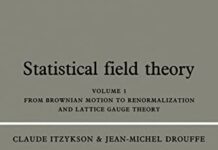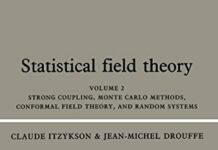
Ebook Info
- Published: 2012
- Number of pages: 756 pages
- Format: PDF
- File Size: 32.50 MB
- Authors: Claude Itzykson
Description
Quantum field theory remains among the most important tools in defining and explaining the microscopic world. Recent years have witnessed a blossoming of developments and applications that extend far beyond the theory’s original scope. This comprehensive text offers a balanced treatment, providing students with both a formal presentation and numerous practical examples of calculations.This two-part approach begins with the standard quantization of electrodynamics, culminating in the perturbative renormalization. The second part comprises functional methods, relativistic bound states, broken symmetries, nonabelian gauge fields, and asymptotic behavior. Appropriate for students and researchers in field theory, particle physics, and related areas, this treatment presupposes a background in quantum mechanics, electrodynamics, and relativity, and it assumes some familiarity with classical calculus, including group theory and complex analysis.
User’s Reviews
Reviews from Amazon users which were colected at the time this book was published on the website:
⭐Quantum Field Theory by Itzykson and Zuber is truly a great text for this subject. The exposition is fairly good as well as a good number of examples without being just a problem book. There is something in it for everyone from experimental particle physicists to theorists. In this way it has a truly broad scope which makes it even more attractive given that you can normally find a copy for under $30. The book is not a great book for a first time exposure to the material, but I came to really appreciate this book when I took QFT using Peskin and Schroder and found that after I worked through most of semester with that text that Itzykson and Zuber became very accessible to me and handles certain topics a little better that P&S. I gave it only 4/5 just for the text not being an real intro type text.
⭐this book was as was described when I ordered it, but when I reviewed it, I was afraid it wouldn’t have any Feynman diagrams (just for the visual and novelty of it) but after receiving the book, I was far from disappointed; plenty of pictorials.
⭐This book is comprehensive, BUT …There are 10 errata pages in the front with 121 entries, mostly in formulas. I don’t dare read it until I mark all the erratas in each chapter. With that many errors, they should have corrected the edition before printing.
⭐After purchasing this book for the Kindle I was very disappointed. On all my devices, the formulas are so small as to be illegible. These is no way to expand them. Don’t waste your money on the Kindle edition.
⭐a classical textbook
⭐This book has been used a great deal both in classes on quantum field theory and as a reference, and, in spite of its date of publication, it could still serve as such, if supplemented with updated materials. There is a lot in this book that one could not find at the time it was published, and was a welcome relief to those who needed a textbook that was more up to date than Bjorken and Drell’s classic work on quantum field theory. Some of the highlights of the book include: 1. The “wave packet” solution of the Dirac equation and the Zitterbewegung phenomenon, which the authors use as a counterexample to the idea of treating negative energy states in the framework of a 1-particle theory. 2. The treatment of two-body relativistic corrections to study the recoil of the nucleus, this being done in the context of the Dirac equation. 3. The use of the Dirac hole theory to motivate the need for a true many-body theory to accomodate particles and antiparticles via quantized fields. 4. A fairly lengthy discussion of the Fock-Schwinger proper time method to obtain an exact expression for the Dirac propagator in a constant uniform electromagnetic field and a plane wave electromagnetic field. 5. The discussion on the use of coherent states to study the positive frequency part of a (free) quantum field. 6. The discussion on charged scalar fields, and why they are needed to formulate a (scalar) theory of particles and antiparticles. 7. The quantization of the electromagnetic field using the Gupta-Bleuler method using an indefinite metric, and the need for retaining the full Fock space (with indefinite norm) in order to preserve locality. 8. The discussion of the vacuum fluctuations via the Casimir effect. 9. The treatment of the Dirac field and the Pauli exclusion principle. The authors begin with two complex fields that both satisfy the Dirac equation, but the Lagrangian then vanishes. They thus are careful to note that canonical quantization will not work, and so they turn to the using their transformation laws under the Poincare group. The derivation of the anticommutators is purely heuristic (and they note this), and they point out that locality would not be satisfied if canonical quantization were followed. The same holds true, as they state also, if one were to quantize a scalar theory according to Fermi statistics. Their discussion here is a neat illustration of the spin-statistics theorem. 10. The discussion of form factors, which they motivate by calling them a relativistic generalization of charge distributions. 11. The discussion of the Euler-Heisenberg effective Lagrangian, and its ability, even though it is “classical”, to model nonlinear phenomena due to quantum corrections. 12. The discussion of the Jost-Lehmann-Dyson representation. 13. The discussion of Euclidean Green functions. 14. The derivation of the Ward-Takahashi identities and the proof that they are preserved by the regularization and renormalization operations. 15. The discussion on functional integration in Bargmann-Fock space, in particular its use in fermion systems. 16. The discussion of the Schwinger-Dyson equations and their use in studying quantum field theory independent of perturbation theory. The existence of a bound state in quantum field theory has yet to be proven using these equations, but they supposedly hold the answer to this existence. The authors give an example of scalar particles interacting via the exchange of scalar particles via the Bethe-Salpeter equation, which are then studied via Wick rotation and where crossed-ladder diagrams are omitted. They also analyze the hyperfine splitting in positronium, but remark that the methods used for this are not entirely satisfactory. 17. The discussion of the sigma model, a topic that has become very important of late. 18. The discussion of asymptotic behavior, the authors emphasizing how the infinities in the relation between bare and renormalized charges and how these infinities must compensate imposes constraints on the theory, which show up in the asymptotic behavior.Some of the omissions which might be expected from a modern standpoint: 1. Representations of the Poincare group. 2. Critical phenomena. 3. Integrable systems in quantum field theory 4. Finite temperature quantum field theory. 5. Quantum field theory in curved spacetime. 6. A more in-depth treatment of instantons (the authors only spend one page on them). 7. Topological quantum field theory.
⭐As anybody who is an expert or a student in the field knows, this is the best book availableon the subject. Dover Publication Inc.’s paperback republication of this book, which wasoriginally by McGraw-Hill, Inc., is an excellent idea. The Dover version has better fontsthat are clearer than the original McGraw-Hill version. On top of that, amazon.com madeit much easier for many people to order it over Internet. I will definitely recommendstudents to buy this paperback version in the future.
⭐a book so cheap yet so great. the shipment is fast too. recommend to others who need it.
⭐Das Buch erschien bereits 1980. Das macht verständlich, warum nicht alle Themen, die heute in der Quantenfeldtheorie von Interesse sind, behandelt werden, aber die Auswahl gibt einen guten Einstieg in die QFT, geschrieben in von ausgewiesenen Experten.Questo libro è esattamente come ci si aspetta che sia un libro di QFT: conciso (spesso i conti non vengono svolti indipendentemente dalla lunghezza). Tuttavia rimane molto chiaro nei concetti, molto ben evidenziati. L’approccio è molto fisico e poco matematico, ma nella mia ignoranza non ho mai visto un libro di QFT particolarmente rigoroso (se qualcuno ne conosce uno me lo dica, grazie). Non posso però non sottolineare un grande difetto: la lista degli errata corrige dura 10 pagine. Non posso controllare, ogni volta che prendo in mano questo libro, se per caso ci sono errori nella pagina.La spedizione è arrivata nei tmepi previsti. Il prodotto era in perfette condizioniBy modern standards this book may be considered old fashioned even though the first author, at least, has been well known in this field for many years. Still, I love it even though I find QFT so difficult to get to grips with
⭐Ottimo libro che avevo già preso in biblioteca, e ho comprato adesso. E’ ben fatto, anche se ha la copertina paperback!! Arrivo addirittura anticipato rispetto al termine fornito da Amazon, quindi Amazon sempre impeccabile!!! Consigliato, detto da uno studente di Fisica della magistrale in Teorica.Best book on QFT.
Keywords
Free Download Quantum Field Theory (Dover Books on Physics) in PDF format
Quantum Field Theory (Dover Books on Physics) PDF Free Download
Download Quantum Field Theory (Dover Books on Physics) 2012 PDF Free
Quantum Field Theory (Dover Books on Physics) 2012 PDF Free Download
Download Quantum Field Theory (Dover Books on Physics) PDF
Free Download Ebook Quantum Field Theory (Dover Books on Physics)

